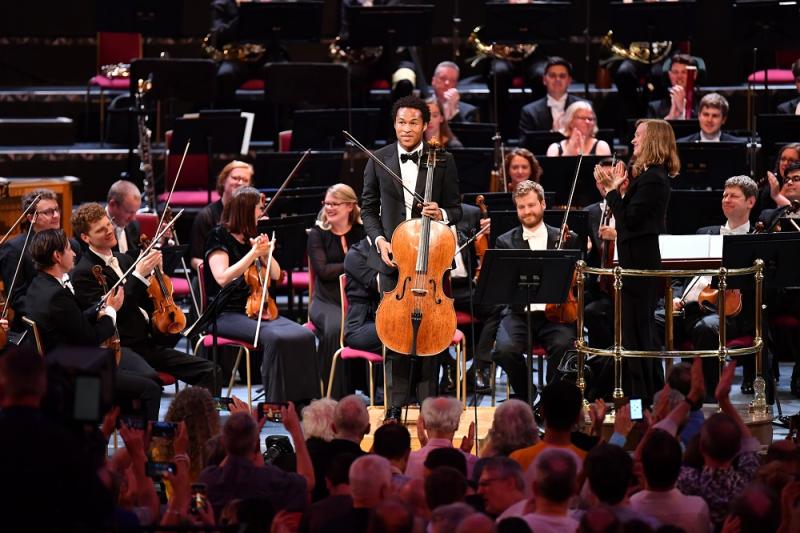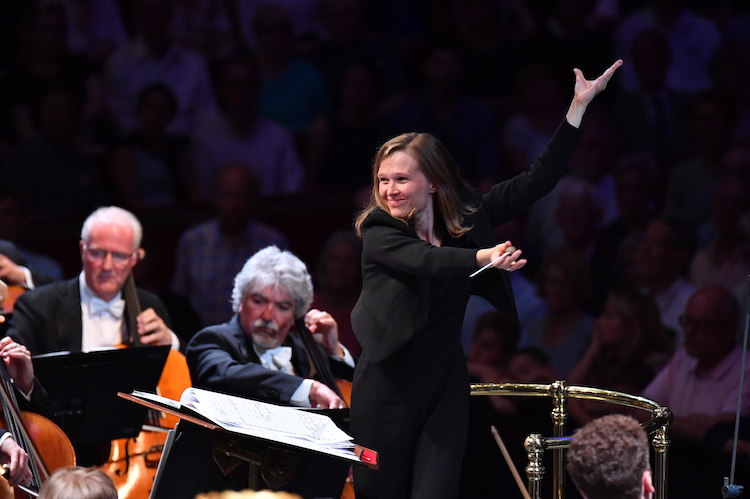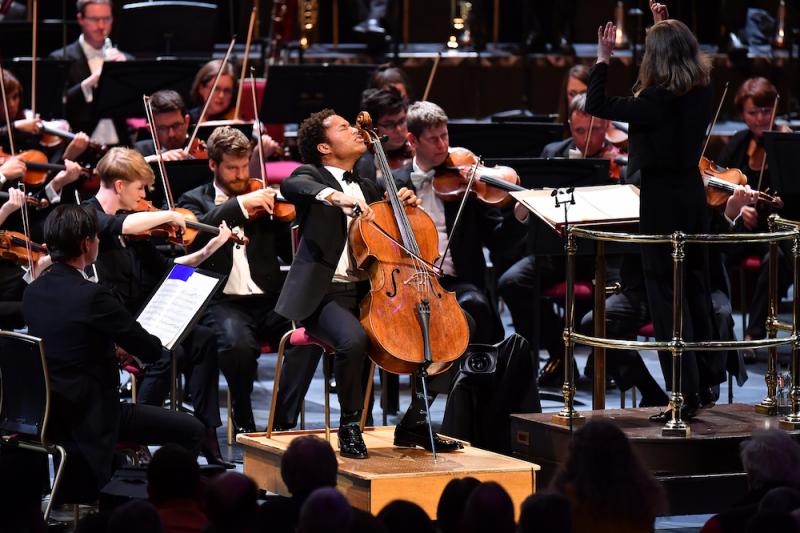Prom 46: Kanneh-Mason, CBSO, Gražinytė-Tyla review - brilliant programme, brilliant playing | reviews, news & interviews
Prom 46: Kanneh-Mason, CBSO, Gražinytė-Tyla review - brilliant programme, brilliant playing
Prom 46: Kanneh-Mason, CBSO, Gražinytė-Tyla review - brilliant programme, brilliant playing
Blend of familiar Elgar with undervalued Weinberg shows the Proms at its best

Let us never tire of singing the praises of the Proms, nor ever take them for granted. For two months concerts, many of which would be the highlight of any ‘normal’ week, keep coming night after night. And for all that it is a critic’s job to comment in detail and find fault where necessary, it is also helpful sometimes to step back and say: the Proms is an astonishing festival which we should be grateful to have.
Dorothy Howell’s short symphonic poem Lamia was completed when she was only 20, performed at the Proms in 1919 to great acclaim and repeated seven more times between 1921 and 1940. It then disappeared from view until its Proms revival in 2010, mirroring the eclipse of the composer herself. For such a young composer it showed mastery of orchestration, from the Ravel-like delicate opening to the sweeping, swooping climaxes later in the piece. There was a terrific solo by oboist Thomas Hutchinson and Graham Sibley had fun with an unusually prominent tuba part. Mirga Gražinytė-Tyla (pictured below by Chris Christodoulou) led the CBSO like a dervish, her whirling gestures capturing the predominantly Wagnerian sound world. Only towards the end did the piece threaten momentarily to sink into Victorian kitsch, only to be rescued by a remarkable ending, dark and unsettling, underpinned by a creaking contrabassoon.
 Elgar’s Cello Concerto was premiered the same year as the Howell but its trajectory has been quite different, accepted as the late masterpiece of a great composer. It was played by Sheku Kanneh-Mason, who has been lionised since winning the BBC Young Musician in 2016 and whose picture appears no less than four times in the concert programme. I hadn’t heard him live before, and I have had a number of experiences of cello concertos not coming over well in the Albert Hall. But there was nothing to worry about, Kanneh-Mason (pictured below) projecting the opening bars powerfully, but still with the suggestion of playing to himself. Part of the success is down to Elgar’s subtle scoring, occasionally allowing the orchestra free rein but mostly paring down the instrumentation when the cello plays. Gražinytė-Tyla was a subtle and fluid accompanist and the orchestra sensitive to Kanneh-Mason’s nuances.
Elgar’s Cello Concerto was premiered the same year as the Howell but its trajectory has been quite different, accepted as the late masterpiece of a great composer. It was played by Sheku Kanneh-Mason, who has been lionised since winning the BBC Young Musician in 2016 and whose picture appears no less than four times in the concert programme. I hadn’t heard him live before, and I have had a number of experiences of cello concertos not coming over well in the Albert Hall. But there was nothing to worry about, Kanneh-Mason (pictured below) projecting the opening bars powerfully, but still with the suggestion of playing to himself. Part of the success is down to Elgar’s subtle scoring, occasionally allowing the orchestra free rein but mostly paring down the instrumentation when the cello plays. Gražinytė-Tyla was a subtle and fluid accompanist and the orchestra sensitive to Kanneh-Mason’s nuances.
The middle movements provided the most interesting contrast. The second has an impishness that gives way to a sumptuousness that is almost camp. Kanneh-Mason caught these changes of tone and was then, in the solemn third movement, able to switch to a Beethovenian expansiveness, but admitting a fragility of tone that was quite moving.  Oliver Knussen’s The Way to Castle Yonder is an off-shoot of his Maurice Sendak opera Higglety-Pigglety Pop! and is scored with his customary teeming detail. At one stage someone in the stalls dropped a bottle, in perfect synchrony with the music, and it wouldn’t have been beyond Knussen to have scored such an effect. There is a whole musical world packed into nine minutes, from delicate soundscape to eccentric galop, and it was delightfully performed.
Oliver Knussen’s The Way to Castle Yonder is an off-shoot of his Maurice Sendak opera Higglety-Pigglety Pop! and is scored with his customary teeming detail. At one stage someone in the stalls dropped a bottle, in perfect synchrony with the music, and it wouldn’t have been beyond Knussen to have scored such an effect. There is a whole musical world packed into nine minutes, from delicate soundscape to eccentric galop, and it was delightfully performed.
The music of Mieczysław Weinberg was new to me – as it was to the Proms where, until the cello concerto was played earlier in the season, it had never been heard. He suffered more than most through 20th century political upheaval, leaving his native Poland when the Nazis invaded and killed his family he ended up in Moscow at the invitation of Shostakovich, but was arrested in 1953 and only released after Stalin’s death. He lived to past the end of the Soviet Union but his vast output is little known.
His Third Symphony of 1950, receiving a belated London premiere, was a demonstration of the fact that there is so much good music out there, largely unperformed in major concerts. This should be a famous piece, and it would be so refreshing to hear a Weinberg cycle in place of the endless Mahler and Shostakovich – but it was noticeable that a good number of people didn’t come back after the interval, presumably scared off by the unfamiliar name. More fool them: they missed a treat.
The music is melodic – using folk songs either in quotation or as a point of reference, colourful and varied, clearly comparable to Shostakovich’s. Gražinytė-Tyla was an incongruously slight figure steering the musical juggernaut in front of her, but her control was total, as was the commitment of the players. The woodwind, in particular, shone, Marie-Christine Zupancic (flute) and Oliver Janes (clarinet) on the mark in all their solos. Most extraordinary was the icy coda to the first movement, utterly bleak, utterly captivating, which made me want to hear this piece again and again.
rating
Explore topics
Share this article
The future of Arts Journalism
You can stop theartsdesk.com closing!
We urgently need financing to survive. Our fundraising drive has thus far raised £49,000 but we need to reach £100,000 or we will be forced to close. Please contribute here: https://gofund.me/c3f6033d
And if you can forward this information to anyone who might assist, we’d be grateful.

Subscribe to theartsdesk.com
Thank you for continuing to read our work on theartsdesk.com. For unlimited access to every article in its entirety, including our archive of more than 15,000 pieces, we're asking for £5 per month or £40 per year. We feel it's a very good deal, and hope you do too.
To take a subscription now simply click here.
And if you're looking for that extra gift for a friend or family member, why not treat them to a theartsdesk.com gift subscription?
more Classical music
 Goldscheider, Brother Tree Sound, Kings Place - music of hope from a young composer
Unusual combination of horn, strings and electronics makes for some intriguing listening
Goldscheider, Brother Tree Sound, Kings Place - music of hope from a young composer
Unusual combination of horn, strings and electronics makes for some intriguing listening
 Helleur-Simcock, Hallé, Wong, Bridgewater Hall, Manchester review - moving lyricism in Elgar’s concerto
Season opener brings lyrical beauty, crisp confidence and a proper Romantic wallow
Helleur-Simcock, Hallé, Wong, Bridgewater Hall, Manchester review - moving lyricism in Elgar’s concerto
Season opener brings lyrical beauty, crisp confidence and a proper Romantic wallow
 Kohout, Spence, Braun, Manchester Camerata, Huth, RNCM, Manchester review - joy, insight, imagination and unanimity
Celebration of the past with stars of the future at the Royal Northern College
Kohout, Spence, Braun, Manchester Camerata, Huth, RNCM, Manchester review - joy, insight, imagination and unanimity
Celebration of the past with stars of the future at the Royal Northern College
 Jansen, LSO, Pappano, Barbican review - profound and bracing emotional workouts
Great soloist, conductor and orchestra take Britten and Shostakovich to the edge
Jansen, LSO, Pappano, Barbican review - profound and bracing emotional workouts
Great soloist, conductor and orchestra take Britten and Shostakovich to the edge
 Jakub Hrůša and Friends in Concert, Royal Opera review - fleshcreep in two uneven halves
Bartók kept short, and a sprawling Dvořák choral ballad done as well as it could be
Jakub Hrůša and Friends in Concert, Royal Opera review - fleshcreep in two uneven halves
Bartók kept short, and a sprawling Dvořák choral ballad done as well as it could be
 Hadelich, BBC Philharmonic, Storgårds, Bridgewater Hall, Manchester review - youth, fate and pain
Prokofiev in the hands of a fine violinist has surely never sounded better
Hadelich, BBC Philharmonic, Storgårds, Bridgewater Hall, Manchester review - youth, fate and pain
Prokofiev in the hands of a fine violinist has surely never sounded better
 Monteverdi Choir, ORR, Heras-Casado, St Martin-in-the-Fields review - flames of joy and sorrow
First-rate soloists, choir and orchestra unite in a blazing Mozart Requiem
Monteverdi Choir, ORR, Heras-Casado, St Martin-in-the-Fields review - flames of joy and sorrow
First-rate soloists, choir and orchestra unite in a blazing Mozart Requiem
 Cho, LSO, Pappano, Barbican review - finely-focused stormy weather
Chameleonic Seong-Jin Cho is a match for the fine-tuning of the LSO’s Chief Conductor
Cho, LSO, Pappano, Barbican review - finely-focused stormy weather
Chameleonic Seong-Jin Cho is a match for the fine-tuning of the LSO’s Chief Conductor
 Classical CDs: Shrouds, silhouettes and superstition
Cello concertos, choral collections and a stunning tribute to a contemporary giant
Classical CDs: Shrouds, silhouettes and superstition
Cello concertos, choral collections and a stunning tribute to a contemporary giant
 Appl, Levickis, Wigmore Hall review - fun to the fore in cabaret and show songs
A relaxed evening of light-hearted fare, with the accordion offering unusual colours
Appl, Levickis, Wigmore Hall review - fun to the fore in cabaret and show songs
A relaxed evening of light-hearted fare, with the accordion offering unusual colours
 Lammermuir Festival 2025, Part 2 review - from the soaringly sublime to the zoologically ridiculous
Bigger than ever, and the quality remains astonishingly high
Lammermuir Festival 2025, Part 2 review - from the soaringly sublime to the zoologically ridiculous
Bigger than ever, and the quality remains astonishingly high
 BBC Proms: Ehnes, Sinfonia of London, Wilson review - aspects of love
Sensuous Ravel, and bittersweet Bernstein, on an amorous evening
BBC Proms: Ehnes, Sinfonia of London, Wilson review - aspects of love
Sensuous Ravel, and bittersweet Bernstein, on an amorous evening

Add comment